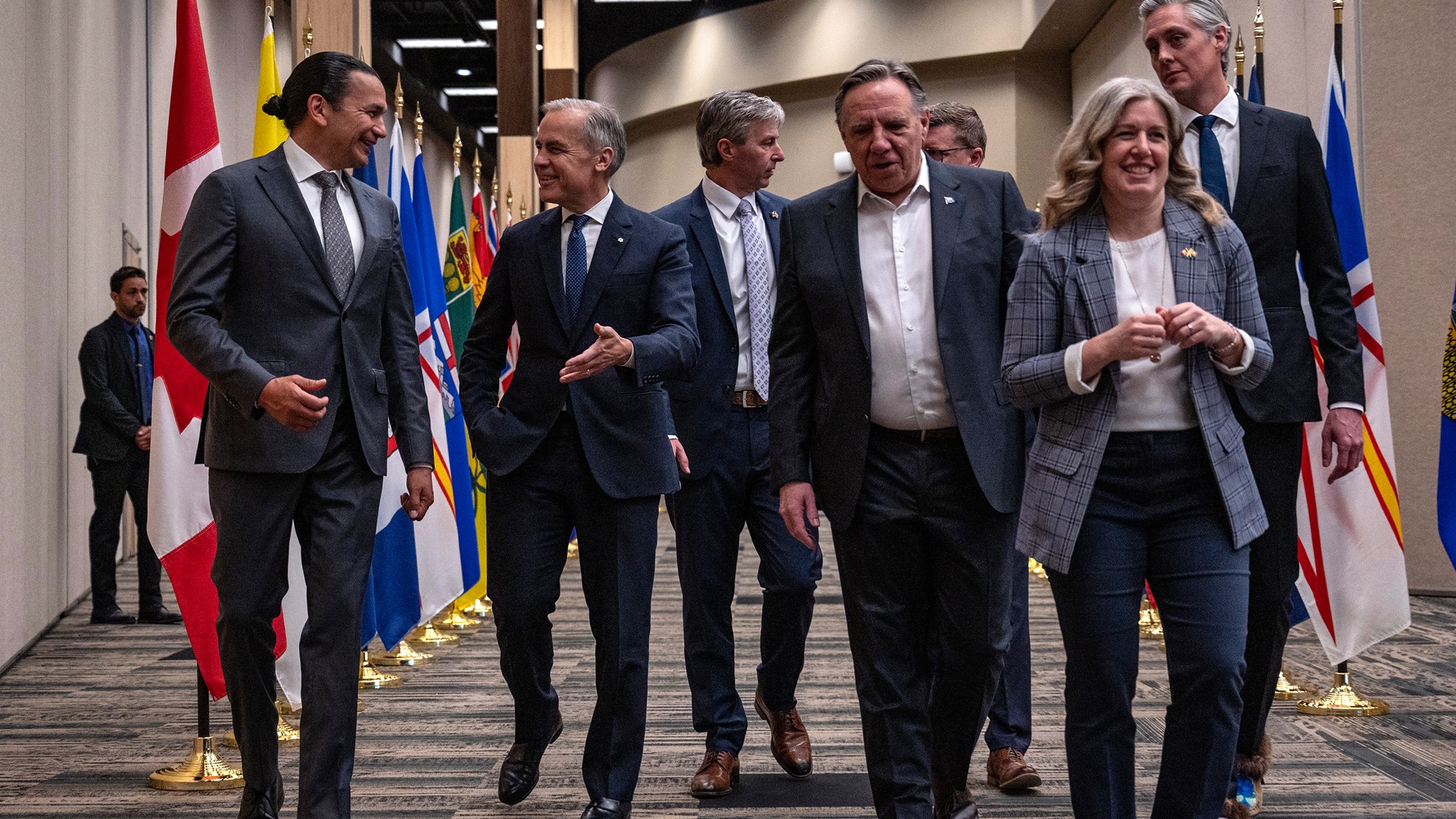
The famous aphorism of the poet Robert Frost is that “good fences make good neighbours.” Yes, but… Do longer, higher, barbed wire, electrified, security patrolled and access-controlled fences make for still better neighbours? Are we walling in or walling out? Likewise, we must recall that even the Great Wall of China ultimately didn’t thwart the barbarians.
In the decade since the events of September 11. 2001, that has become the baseline question in Canada-US relations. The throw-away line has been “security trumps trade.” Again, yes, but… How much security at what cost to what amount of trade?
And thus the question becomes whether the massive about-to-be-realized effort to create “beyond the border” perimeter security around Canada and the United States is the answer, the right approach, a half step in the right direction, or is substantially/totally misguided.
But we need context to discuss an issue that frequently generates lightless heat.
For the United States, the post-9/11 environment has remained profoundly challenging and depressing. The psychological pressures associated with incipient terrorism are accentuated by the worst economic circumstances that the vast majority of Americans have ever encountered. And neither the threat of terrorism nor the exigencies of the shrunken economy shows any near-term likelihood of being mitigated let alone solved.
The United States is deeply into pessimism — in contrast to a historic optimism that characterized its society.
The “hope and change” president no longer generates hope that he can change the economy positively (instead murmurs of a “double dip” recession persist), and for many citizens their major “hope” is that “change” will replace him in 2012. The societal pessimism results in caution; again, the pessimistic outlook for the economy reinforces this caution.
Americans were hurt in 9/11 — perhaps more deeply and for a longer term than we realized at the time or realize now. Concurrently, we are being hurt by the Great Recession, and the commensurate Keynesian-driven solutions have resulted in a massive national debt/deficit that appears to be mortgaging America’s grandchildren — without getting the grandparents out of the recession.
Nor is there is a clear way of escaping from either terrorism or the economic slump. Terrorism is amorphous; 9/11 was not Pearl Harbor, where the answer was straightforward: defeat the Japanese, occupy their country, change their social/political system and ensure that never again could Japan attack the US. The same approach served to address German fascism: defeat Hitler, occupy Germany and give German politics a do-over, eliminating the fear of German military aggression or a Holocaust level massacre.
At the 10-year commemoration of the 9/11 attack, US fears of terrorism were less publicly overt (no air cap flights over major cities for the events). But they remain profoundly internalized; the next “shoe” will drop, but when/where/how is totally unknown. Osama Bin Laden is dead —and that is a good thing—and various of his cohorts and al-Qaeda clones have also been killed (likewise a good thing). But it takes very few motivated, equipped individuals to kill hundreds, perhaps thousands.
Although we focus on commandeered aircraft in a possible replication of 9/11, there are endless variants that have been demonstrated globally in London subways, Russian schools/theatres, Spanish trains and the like. We are at least subliminally aware of these bloody attacks.
Critics, including Canadians, look at US attitudes and remark to the effect that Americans are paranoid when they should only be neurotic — but even paranoids have real enemies. And America’s enemies appear endlessly creative: the “shoe bomber,” the “underwear bomber,” the air freight/Fedex style bombs. Unfortunately, the information for producing homemade high explosives from fertilizer and diesel fuel — a Second World War innovation designed to help French maquis sabotage German occupation — is widely distributed on the Internet. As demonstrated in the 1995 Oklahoma City bombing, comparable low tech efforts can be made by terrorists around the world.
It takes very few motivated, equipped individuals to kill hundreds, perhaps thousands. Although we focus on commandeered aircraft in a possible replication of 9/11, there are endless variants that have been demonstrated globally in London subways, Russian schools/theatres, Spanish trains end the like. We are at least subliminally aware of these bloody attacks.
In some respects, the tension of waiting for the next successful attack is almost worse than living (as do the Israelis, Iraqis and Afghans) with regular terror attacks. Terror becomes part of their climate: mid-Western homes have storm cellars against tornadoes; hurricane areas have comparable shelters and evacuation routes; homes and cars in snow belt climates are equipped to cope with blizzards. So we lock and relock barn doors, recognizing that there are more horses that could get loose. And we put on the equivalent of “belt and suspenders” by taking off shoes, removing edged implements from pockets, limiting sizes of containers, etc. But it doesn’t make us feel really safe and, therefore, we keep searching for still higher technology devices to fend off the inevitable.
Evil need not be stupid; it can be as creative as good. The economic challenges from the Great Recession stimulate two contending answers: (a) dramatic cuts in government spending at all levels and in all functions with concurrent reductions in social services; and (b) significant tax increases (particularly on “the rich”) with minimal or no reductions in social services.
The US citizenry is at loggerheads over which approach (or combination thereof) should be implemented to secure the greatest benefit with the least pain. There is intense, politically motivated suspicion on both sides. We are flailing about for answers and increasingly frustrated over their absence. One result has been impatience with trading partners such as China, who some believe have caused, or at least contributed to, US economic pain. The primary target has been China, whose vast trade surplus with the US and blatant currency manipulation combined with disrespect for intellectual property rights have certainly contributed to job loss and factory closures.
The attitude also made it particularly difficult to reach agreement on even trivial new “free trade” agreements such as those finally concluded with the Republic of Korea, Colombia, and Panama in mid-October that had been hanging fire for years. Fatuous fears, driven by union members, kept them shelved, until the forcing event of the state visit by the Korean President raised the embarrassment potential to a level not even Democratic ideologues were willing to face.
Even Canada has been sideswiped by these recession-driven fears. Ottawa has had to deal with eruptions of “Buy America” legislation in Congress, regardless of its unlikely chance of passage (while recognizing that various US states and Canadian provinces have greater trade barrier restrictions on government purchasing). Such economic activity is always self-interested but particularly poignant and bitter when the economy is feeble.
A less obvious but still pertinent element of the trade/security conundrum is the environmental battle juxtaposing “dirty” versus “ethical” oil from the Alberta oil sands, which US critics, including the New York Times, persist in calling the tar sands. Here both economics/trade and security combine happily, providing a secure energy source not subject to the vagaries of Middle East politics. Agreement to it has been characterized as a “no-brainer.” Alas, environmentalists have demonstrated the opposite, spent years screaming about it and implying that they could make the Keystone XL pipeline insecure were it to be built.
Canadian-US trade remains very high after a Great Recession dip in 2009, recovering in 2010, albeit not to 2008 levels. Still the US is the destination for 75 to 80 percent of Canada’s exports, and thus any potential disruption of trade raises red flags and cries of anguish.
Essentially, Canadians resent the end of the “good old days” when the national border was no more a barrier than travelling from Ontario to Quebec. If not a fool’s paradise, it is now a bygone era. Americans resent Canadian resentment. Professionals recognize that none of the 9/11 hijackers transited Canada; but professionals also realize they could easily have done so. Instead of appreciating and accepting this reality, all too often Canadian media has focused on individuals with problems transiting the US border, associated delays and disruptions, individuals wrongly placed on “do not fly” lists (including twice the US ambassador) and the generally tedious and unpleasant endurance contest associated with cross-border travel. If security has trumped economics in the United States, “privacy” has been the shibboleth for Canadians. It has been hard to convince Canadians that US inspectors are not interested in Aunt Matilda’s doings in Ottawa but may be concerned with Mr. Mohammed’s travels to foreign destinations more noted for terrorist training than tourism.
Nevertheless, it is clear that the border has been “thickening” over the post-9/11 decade. Every thwarted terrorist attempt has prompted a new layer of security; although we are not yet travelling in hospital paper gowns permitted only to carry our computer chip passports, the full-body screening electronically strips us naked.
In the process, the economic innovation of “just in time” procurement, dependent on swift unimpeded movement of goods within and across borders, has become increasingly sclerotic with proverbial hours-long truck lines awaiting inspection at key border crossings. Ultimately, it is absurd that auto parts crisscrossing the US-Canadian border may require a half dozen clearances while a fully assembled foreign car needs but one. Time is money; it is not that Americans are indifferent to this economic reality, but solutions that both facilitate trade and ensure security have been devilishly difficult to devise.
As large, open, multiculturally diverse societies, we are axiomatically vulnerable to threat, both from inside and out. Whether we must counter a Toronto 16 or a Fort Dix Six, we cannot ignore the reality of threat. We cannot, North Korea style, hermetically seal ourselves from threat — even attempting to do so would make us something other than the United States and Canada. But we can do more — and little by little, we are.
That does not mean that the process has been easy. Since human rights activists de facto prevent profiling (by double-checking all swarthy males under 45 years old), little old ladies, overweight Caucasian businessmen, perky GenX females and twitchy 20-something males legally are accorded the same attention. Obviously, time is wasted in the process.
Nor can we believe that our best and brightest serve as Transportation Security Administration inspectors and wand-wavers at airports. There have been too many sotte voce reports of various prohibited items passing undetected through X-ray machines to permit the traveller to be sanguine about inspector competence.
Nevertheless, there have been partial successes in creating the equivalent of “trusted traveller” identification cards with embedded microchips for those who travel frequently across the border. But these are expensive and time-consuming to acquire. As a consequence, also driven by financial factors such as passport requirements, Great Recession limits on travel and reduced incentive to shop as exchange rates have gyrated, cross-border travel has declined. (US travel to Canada was down 50 percent from 2000 to 2009; Canadian travel is not as greatly affected but remains lower than peaks.)
And there have been false starts. One recalls plans for a joint border facility to be constructed on the Canadian side of the border at one crossing point due to land constraints on the US side. After extensive discussions, the plans were cancelled because Canada would not agree to detain individuals who approached the border crossing but didn’t complete the attempt. The US government wanted to investigate such individuals who could be probing for weaknesses in procedures or seeking to discover tactics to assure access. Canadians deemed such action an invasion of their privacy.
The concept of a security perimeter around North America (or at least covering Canada and the United States) has been bruited about from the beginning of post-9/11 security planning. Effective security at sea and air ports (and prior to the departure of ships and planes from foreign venues) could thwart potential threats and, coincidentally, reduce the need for intensive, intrusive and time-consuming security efforts at the Canada-US border. The logic is impeccable, but the devilish details have constantly intruded.
In February, however, following a meeting of President Obama and Prime Minister Harper in Washington, the sides announced the Regulatory Cooperation Council with a two-year mandate to “promote economic growth, job creation, and benefits to our consumers and businesses through increased regulatory transparency and coordination.” The objective was for “smarter, more effective approaches to regulation…[but] in no way diminish the sovereignty of either the United States or Canada…”
As of late October, an official announcement of a Beyond the Border agreement has been hanging fire, seeking an appropriate venue that would be prominent enough to satisfy Canadian desires for a high profile summit style announcement — while not taking too much presidential time.
The US and Canada were to “develop, implement, manage, and monitor security initiatives, standards, and practices…[and] use a risk management approach…to address the threats we share.” Such risk management was to be directed to “accelerate legitimate flows of people and goods…while enhancing [mutual] physical security and economic competitiveness.” In this regard, there was to be “greater sharing of information” (while demonstrating “respect for our separate constitutional and legal frameworks that protect privacy, civil liberties, and human rights and provide for appropriate recourse and redress.”)
It hit all the appropriate buzz-words — sovereignty, privacy, security.
There were a host of specific topics to be addressed, including an integrated cargo screening strategy for goods before they depart foreign ports for the United States and Canada. We would further integrate cross-border law enforcement to counter individuals and organizations involved in transnational crime. We would strengthen cybersecurity as well as enhancing the security of transportation and communication networks in and on air, land, sea and space.
Action was accorded to an interagency Beyond the Border Working Group to report to the President and Prime Minister with a sooner rather than later impetus.
In grinding through these principles/platitudes for six months, negotiators reportedly elected to avoid a number of toxic topics such
as immigration, refugee standards and the harmonization of some security measures. A deal reportedly was ready by late September (timing had been for a summer announcement), which would include the following, inter alia:
- Synchronized international coordination and planning at land border crossings;
- “One stop shopping” for importers who now deal with up to half a dozen government agencies combined with reduced paperwork requirements;
- Special visas for certain business travelers and more emphasis on frequent traveler programs; and
- Detailed benchmarks to bring food and auto industries into line. It will not come cheap. Projections for new facilities and equipment to put Canada in the same technological ballpark as the United States run to $1 billion.
And implementation will take time; reportedly, the action plan will incorporate several dozen items, some to be concluded in months, but others may require four or five years to implement.
Predictably there also has been lamentation from the opposition when elements of the impending agreement leaked. Liberal interim leader Bob Rae demanded that it be presented to Parliament before agreement and complained that “Buy America” provisions in the Obama jobs bill constituted harassment and contradicted the spirit of any agreement. The demise of the jobs bill due to Republican congressional opposition (and with it the “Buy America” element) will require Rae to invent a new objection. NDP MP Thomas Mulcair, however, has latched on to a hardy perennial: the government’s failure to appropriately defend Canadian sovereignty (one doubts whether he would be satisfied with less than the United States paying reparations for burning York in 1813).
But the ability to execute an agreement is essentially a function of the Tory majority victory in May (and the happy coincidence that the United States is not yet in full election campaign mode).
As of late October, an official announcement of a Beyond the Border agreement has been hanging fire, seeking an appropriate venue that would be prominent enough to satisfy Canadian desires for a high profile summit style announcement — while not taking too much presidential time.
Have we squared the circle with a perimeter protection projection? Doubtless not. We will continue to struggle with partial solutions accentuated by new sets of problems that now are “unknown unknowns.” But it appears as if Beyond the Border will institutionalize a flexible framework to address ongoing issues that will survive changes of administration. It could be (and has been) a lot worse; Beyond the Border suggests better days are ahead.
Photo: Shutterstock







